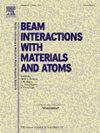Four-step evaluation and systematic assessment of various containers for radioactive source transportation purposes
IF 1.4
3区 物理与天体物理
Q3 INSTRUMENTS & INSTRUMENTATION
Nuclear Instruments & Methods in Physics Research Section B-beam Interactions With Materials and Atoms
Pub Date : 2025-03-14
DOI:10.1016/j.nimb.2025.165683
引用次数: 0
Abstract
The multifunctional La2O3-TiO2-Nb2O5-B2O3 glass system was evaluated for its gamma-ray and neutron shielding capabilities, focusing on its potential use as transparent containers for radioactive isotope transport. Critical shielding parameters, including linear attenuation coefficients, half-value layers, equivalent atomic numbers, and transmission factors, were analyzed using Monte Carlo simulations and other computational methods. Among the investigated samples, the 16Nb2B glass exhibited exceptional performance, with an LAC of 7.0613 cm−1 at 0.01 MeV, outperforming the 40La14B glass by 29 %. Its HVL was as low as 0.003 cm at 0.015 MeV and 1.725 cm at 0.662 MeV, marking a considerable reduction compared to steel-magnetite concrete. Moreover, the deposited energy in the air surrounding 16Nb2B was 1.18 × 10-4 MeV/g, reflecting reductions of 59.9 % and 56.1 % compared to Boron Carbide and cement-bitumen mixtures, respectively. The TF values for 16Nb2B consistently showed superior attenuation, with reductions of 6.6 % at 3.0 cm thickness and 0.662 MeV compared to steel-magnetite concrete. It can be concluded that the 16Nb2B glass not only provides outstanding optical transparency properties but also provides better radiation shielding properties, making it a promising candidate for applications in medical imaging, nuclear facilities, and radioactive material transport.
各种放射源运输容器的四步评价与系统评价
对多功能La2O3-TiO2-Nb2O5-B2O3玻璃体系的伽马射线和中子屏蔽能力进行了评估,重点是其作为放射性同位素运输透明容器的潜力。利用蒙特卡罗模拟和其他计算方法分析了屏蔽的关键参数,包括线性衰减系数、半值层数、等效原子序数和透射系数。在所研究的样品中,16Nb2B玻璃表现出优异的性能,在0.01 MeV下LAC为7.0613 cm−1,比40La14B玻璃高出29%。其HVL在0.015 MeV时低至0.003 cm,在0.662 MeV时低至1.725 cm,与钢-磁铁矿混凝土相比显著降低。此外,16Nb2B周围空气中沉积的能量为1.18 × 10-4 MeV/g,与碳化硼和水泥-沥青混合物相比,分别降低了59.9%和56.1%。与钢-磁铁矿混凝土相比,在3.0 cm厚度和0.662 MeV下,16Nb2B的TF值始终表现出优异的衰减,降低了6.6%。综上所述,16Nb2B玻璃不仅具有出色的光学透明性能,而且具有更好的辐射屏蔽性能,在医学成像、核设施和放射性物质运输方面具有很好的应用前景。
本文章由计算机程序翻译,如有差异,请以英文原文为准。
求助全文
约1分钟内获得全文
求助全文
来源期刊
CiteScore
2.80
自引率
7.70%
发文量
231
审稿时长
1.9 months
期刊介绍:
Section B of Nuclear Instruments and Methods in Physics Research covers all aspects of the interaction of energetic beams with atoms, molecules and aggregate forms of matter. This includes ion beam analysis and ion beam modification of materials as well as basic data of importance for these studies. Topics of general interest include: atomic collisions in solids, particle channelling, all aspects of collision cascades, the modification of materials by energetic beams, ion implantation, irradiation - induced changes in materials, the physics and chemistry of beam interactions and the analysis of materials by all forms of energetic radiation. Modification by ion, laser and electron beams for the study of electronic materials, metals, ceramics, insulators, polymers and other important and new materials systems are included. Related studies, such as the application of ion beam analysis to biological, archaeological and geological samples as well as applications to solve problems in planetary science are also welcome. Energetic beams of interest include atomic and molecular ions, neutrons, positrons and muons, plasmas directed at surfaces, electron and photon beams, including laser treated surfaces and studies of solids by photon radiation from rotating anodes, synchrotrons, etc. In addition, the interaction between various forms of radiation and radiation-induced deposition processes are relevant.

 求助内容:
求助内容: 应助结果提醒方式:
应助结果提醒方式:


